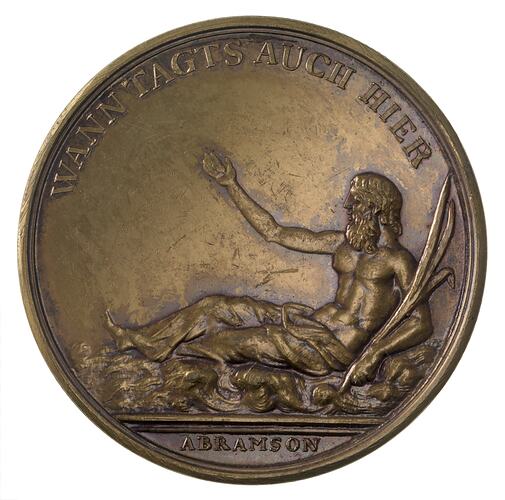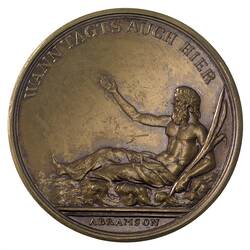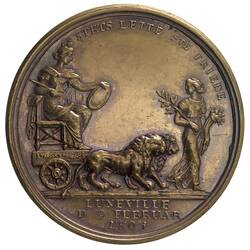Summary
Medal Peace of Luneville, Issued by Germany, 1801 (Late strike in France, post 1880)
Minted in Paris
Obverse Description
Turreted female (Cybele) seated on cart drawn by two lions to right, following female (Peace) walking right but looking back, holding a cornucopia and an olive branch; around above, STETS LEITE STE FRIEDE; in exergue, LUNEVILLE / D 9 FRBRUAR / 1801
Reverse Description
River god seated in river facing left, right arm raised; around above, WANNTAGS AUCH HIER; in exergue, ABRAMSON
Edge Description
Stamped with cornucopia BRONZE
Significance
The dies for this medal were cut by Abraham Abramson (1754-1811) possibly at the Berlin mint. The dies later came into the possesssion of a Frenchman, Brasseaux, who had the Paris mint strike examples for collectors. These fall into two phases, the earlier stamped on the edge COPIE, and the later (this piece being an example) struck and authorised by the Paris mint itself, and bearing their edge marking of a cornucopiae and the word BRONZE (this mark came into use in 1880).
On the Peace of Luneville: "After several armistices had been entered into between Austria and the French Republic, and as often suffered to expire from the jarring interests of the different powers, Austria at length found it necessary to enter into a treaty for peace, separate and alone, which after many delays, was definitively agreed upon between the first Consul of the French Republic and the Emperor. This treaty was concluded at Luneville, in February, 1801. ... It agreed, first, that there was to be a permanent peace between the French Republic and the Emperor; the Belgic provinces, Falkenstein and its dependencies; the Frickthal, and all that belongs to the house of Austria on the left bank of the Rhine, between Zurzach and Basle, to be given up to the French. Istria, Dalmatia, and the Venetian Isles dependant on those countries; the Bocca di Cattaro, the city of Venice, the Adriatic sea, and the Adige from its leaving the Tyrol to the mouth of the said sea, to belong to the Emperor, the towing path of the Adige, being the line of limitation. Draw-bridges to be established in the middle of the cities of Verona and Porto Legnano, to mark the separation of this line ..." Laskey, p.45-46.
More Information
-
Collecting Areas
-
Acquisition Information
Transfer from National Gallery of Victoria (NGV), 15 Mar 1976
-
Issued By
-
Artist
-
Series
-
Material
Bronze
-
Axis
12
-
Classification
-
Category
-
Discipline
-
Type of item
-
Dimensions
42 mm (Outside Diameter), 32.7 g (Weight)
-
Shape
Round
-
Keywords


